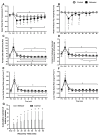Thermal Behavior Augments Heat Loss Following Low Intensity Exercise
- PMID: 31861405
- PMCID: PMC6981425
- DOI: 10.3390/ijerph17010020
Thermal Behavior Augments Heat Loss Following Low Intensity Exercise
Abstract
We tested the hypothesis that thermal behavior alleviates thermal discomfort and accelerates core temperature recovery following low intensity exercise. Methods: In a 27 0 C, 48 6% relative humidity environment, 12 healthy subjects (six females) completed 60 min of exercise followed by 90 min of seated recovery on two occasions. Subjects wore a suit top perfusing 34 ± 0 °C water during exercise. In the control trial, this water continually perfused throughout recovery. In the behavior trial, the upper body was maintained thermally comfortable by pressing a button to receive cool water (3 2 °C) perfusing through the top for 2 min per button press. Results: Physiological variables (core temperature, p ≥ 0.18; mean skin temperature, p = 0.99; skin wettedness, p ≥ 0.09; forearm skin blood flow, p = 0.29 and local axilla sweat rate, p = 0.99) did not differ between trials during exercise. Following exercise, mean skin temperature decreased in the behavior trial in the first 10 min (by -0.5 0.7 °C, p < 0.01) and upper body skin temperature was reduced until 70 min into recovery (by 1.8 1.4 °C, p < 0.05). Core temperature recovered to pre-exercise levels 17 31 min faster (p = 0.02) in the behavior trial. There were no differences in skin blood flow or local sweat rate between conditions during recovery (p ≥ 0.05). Whole-body thermal discomfort was reduced (by -0.4 0.5 a.u.) in the behavior trial compared to the control trial within the first 20 min of recovery (p ≤ 0.02). Thermal behavior via upper body cooling resulted in augmented cumulative heat loss within the first 30 min of recovery (Behavior: 288 92 kJ; Control: 160 44 kJ, p = 0.02). Conclusions: Engaging in thermal behavior that results in large reductions in mean skin temperature following exercise accelerates the recovery of core temperature and alleviates thermal discomfort by promoting heat loss.
Keywords: exercise recovery; thermoregulation; thermoregulatory behavior; voluntary cooling.
Conflict of interest statement
R.G. is the research director for Explorations in the Whitespace Innovation Team at Lululemon Athletica, Inc. N.T.V. and Z.J.S. have received travel funding from Lululemon Athletica Inc.
Figures






Similar articles
-
Thermal behavior alleviates thermal discomfort during steady-state exercise without affecting whole body heat loss.J Appl Physiol (1985). 2019 Oct 1;127(4):984-994. doi: 10.1152/japplphysiol.00379.2019. Epub 2019 Aug 15. J Appl Physiol (1985). 2019. PMID: 31414951
-
Skin wettedness is an important contributor to thermal behavior during exercise and recovery.Am J Physiol Regul Integr Comp Physiol. 2018 Nov 1;315(5):R925-R933. doi: 10.1152/ajpregu.00178.2018. Epub 2018 Aug 22. Am J Physiol Regul Integr Comp Physiol. 2018. PMID: 30134737
-
Increased skin wetness independently augments cool-seeking behaviour during passive heat stress.J Physiol. 2020 Jul;598(13):2775-2790. doi: 10.1113/JP279537. Epub 2020 May 27. J Physiol. 2020. PMID: 32347543
-
Effects of thermal stress during rest and exercise in the paediatric population.Sports Med. 1998 Apr;25(4):221-40. doi: 10.2165/00007256-199825040-00002. Sports Med. 1998. PMID: 9587181 Review.
-
How humans adapt to hot climates learned from the recent research on tropical indigenes.J Physiol Anthropol. 2022 Jul 14;41(1):27. doi: 10.1186/s40101-022-00302-3. J Physiol Anthropol. 2022. PMID: 35836266 Free PMC article. Review.
Cited by
-
Human thermoregulation during prolonged exposure to warm and extremely humid environments expected to occur in disabled submarine scenarios.Am J Physiol Regul Integr Comp Physiol. 2020 May 1;318(5):R950-R960. doi: 10.1152/ajpregu.00018.2020. Epub 2020 Apr 1. Am J Physiol Regul Integr Comp Physiol. 2020. PMID: 32233779 Free PMC article.
References
Publication types
MeSH terms
LinkOut - more resources
Full Text Sources
Medical

